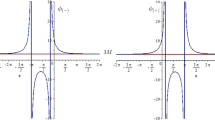Abstract
The generation of infinite redshift surface is due to the singularity of the Lorentz transformation; according to this fact, analyzing the singularity of the parameters in the Lorentz transform factor, which is named the Lorentz factor analysis method in this paper, can be used to research the dynamic effect of the infinite redshift surface. In this paper, the method is applied to the Reissner–Nordstrom and Kerr–Newman black hole spacetime, which finds that the infinite redshift surface will expand and contract with the observer’s radial motion, and the corresponding equations are given clearly. A new proof of the inaccessibility of the time-like singularity in a charged black hole is given, and the inaccessibility of the time-like singularity is proved only related to the electrical nature, it has nothing to do with rotation. The study result of space-like quasi-circular motion observer shows that the infinite redshift surface is consistent with that of the static observer at infinity in this case. The minimum blueshift radius, which is proposed in the study of the observer who escapes at the speed of light in normal spacetime, makes a stronger constraint on black hole parameters than traditional condition. This is a possible reason why it is difficult to form an intermediate-mass black hole; discussion about it can be found at the end of the paper.




Similar content being viewed by others
References
B. McInnes, Y.C. Ong, Classical. Quant. Grav. 38, 3 (2020)
P.V. Cunha, C.A. Herdeiro, M.J. Rodriguez, Phys. Rev. D 97, 8 (2018)
D.B. Canário, S. Lloyd, K. Horne, C.A. Hooley, Phys. Rev. D 102, 8 (2020)
O.B. Zaslavskii, Gen. Relat. Gravit. 52, 4 (2020)
T. Padmanabhan, Classical. Quant. Grav. 19, 21 (2002)
A. Ghosh,A. Perez, Phys. Rev. Lett., 107,24(2011)
L. Berezhiani, G. Chkareuli, C. De Rham etc. J. Phys. Rev. D,85,4(2012)
Liu. Liao, Zhao. Zheng General relativity. Higher Education Press. (2004)
J. Franks, Ann. Math. 128, 1 (1988)
Z. Zheng, Chinese Phys. Lett. 14, 5 (1997)
S.K. Chakrabarti, R. Geroch, C.B. Liang, J. Math. Phys. 24, 3 (1983)
P. Bambhaniya, A.B. Joshi, D. Dey, P.S. Joshi, Phys. Rev. D 100, 12 (2019)
E.T. Newman, E. Couch, Chinnapared, etc. J. Math. Phys. 6, 6 (1965)
M. Coleman Miller, E. Colbert, J. Int. J. Mod. Phys. D 13, 1 (2004)
E. Tremou, J. Strader, etc. Astrophys. J.,862,1(2018)
J. A. Regan, J. H. Wise, etc. The Open J. Astrophys.,3,1(2020)
J. Fuller, L. Ma, The Astrophys. J. Lett. 881, 1 (2019)
V. L. Afanasiev, Y. N. Gnedin, etc. Astro. Lett., 44,6(2019)
W. Yong-Cheng, X. Ping, Nuov. Cim. B 106, 1287 (1991)
Acknowledgements
Thanks to Yuan Tu from the college of physics, the Sichuan University of China, for her support in the numerical part of this paper. Thanks for the support provided by the Society of Theoretical and Computational Physics, the College of Engineering and Technology of CDUT.
Author information
Authors and Affiliations
Corresponding author
Rights and permissions
About this article
Cite this article
NI, J., Tu, Y. On the dynamic effect of infinite redshift surface: Lorentz factor analysis method. Eur. Phys. J. Plus 136, 1001 (2021). https://doi.org/10.1140/epjp/s13360-021-01984-x
Received:
Accepted:
Published:
DOI: https://doi.org/10.1140/epjp/s13360-021-01984-x




